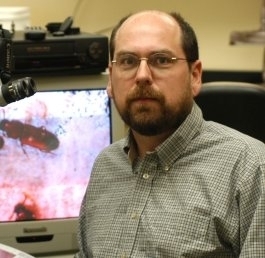
There will be plenty of people to bug.
Some 3200 entomologists or persons interested in insects are registered to attend.
Our own Frank Zalom, distinguished professor of entomology in the UC Davis Department of Entomology and Nematology, serves as president of the 7000-member organization, founded in 1889. He's the second UC Davis entomologist to hold the office. The first was Donald McLean (1928-2014), emeritus professor and former chair of the department.
Zalom, an integrated pest management specialist, has selected his theme as "Grand Challenges Beyond Our Horizon," a perfect theme for a meeting in the Great Northwest.
Richard Levine, communications program manager for ESA, says that more than 90 symposia are planned and will cover such topics as bed bugs, honey bees, monarch butterflies, ticks, native pollinators, pesticide regulations, biological control, integrated pest management, genetically-modified crops, invasive species, forestry, entomophagy, organic farming, insect-vectored diseases, and more. In addition, there will be 1,750 papers and posters, Levine reports.
Highlights include:
- Beyond Pesticides: The Conundrum of Bed Bugs
- Insects as Sustainable and Innovative Sources of Food and Feed Production
- Recovering Monarch Butterfly Populations in North America: A Looming Challenge for Science, the Public, Industry, and Legislators
- Classical Biological Control of the Brown Marmorated Stink Bug, Halyomorpha halys (Stål)
- Nutrition and the Health and Behavior of Wild and Managed Bees
- Contributions of Mosquito Research to Science & Society
- Entomological Comics and Their Importance in Education and Culture
- RNAi: Emerging Technology to Overcome Grand Challenges in Entomology
- IPM: An International Organic Farming Strategy on Invasive Insect Species
- New Frontiers in Honey Bee Health Economics: Incorporating Entomological Research and Knowledge into Economic Assessments
UC Davis will have quite a presence at the meeting. Among the scientists to be honored at the ESA meeting are three from UC Davis: Professor Diane Ullman and doctorate recipients Kelly Hamby (2014) and James F. Campbell (1999)

Kelly Hamby, recipient of the John Henry Comstock Graduate Student Award from the Pacific Branch of ESA, will be honored, along with the other Comstock award winners from the other branches. (See more information)

Research entomologist James F. Campbell, who earned his doctoral in entomology from UC Davis in 1999, will receive a special recognition award. The award, sponsored by Syngenta Crop Protection, recognizes entomologists who are making significant contributions to agriculture. Campbell is a research entomologist with the Center for Grain and Animal Health Research Service of the USDA's Agricultural Research Service, Manhattan, Kansas. (See more information)
Three professors who received their doctorates in entomology in the 1980s from UC Davis are among this year's 10 elected Fellows.
They are:
- Nilsa A. Bosque-Pérez, professor, Department of Plant, Soil and Entomological Sciences at the University of Idaho. She received two degrees from UC Davis: her master's degree in 1981 and Ph.D. in 1985.
- Gary Felton, professor and head of the Department of Entomology at Penn State University. He received his doctorate from UC Davis in 1988. In 2010, he delivered the Thomas and Nina Leigh Distinguished Alumni Lecture at UC Davis
- Murray B. Isman, professor of entomology and toxicology at the University of British Columbia, Vancouver. He received his doctorate from UC Davis in 1981. In 2010, he delivered the Thomas and Nina Leigh Distinguished Alumni Lecture at UC Davis

Many faculty and students will present talks or displays at the event.
Each participant will receive a copy of the 2014 ESA calendar, which features the work of insect photographers throughout the world.
A red flameskimmer dragonfly (Libellula saturata), taken by yours truly, is among the images. I bugged the bug. "Lib" perched on a bamboo stake near our fish pond and was not at all skittish when I walked up and asked "Okay if I bug you for a photo? After you polish off that sweat bee?"
In bug language, Lib said "Go ahead. Just get my best side, please."
So I did. Lib's best side. And then I wrote the requisite caption about this amazing dragonfly.
"The flameskimmer dragonfly (Libellula saturata) is native to western North America. It feeds on bees, flies, moths and other soft-bodied insects, catching them in flight and returning to a perch to eat. The males, about two to three inches long, are larger than the females. The males are firecracker red or dark orange, while the females are a medium to a darker brown. Adult dragonflies hang out at ponds, streams, ditches and at other water habitats. Females lay their eggs in warm ponds or small streams. The nymphs ambush their prey, feeding on insect larvae, including mosquitoes and aquatic flies. The nymphs also eat small fish, tadpoles and each other."
Attached Images:
